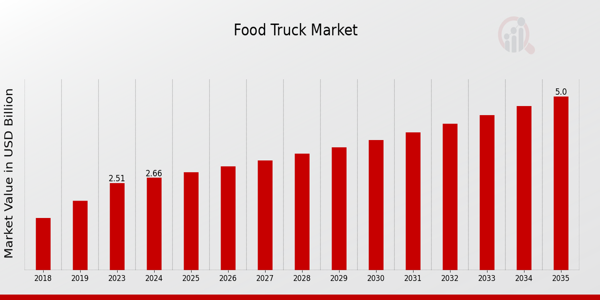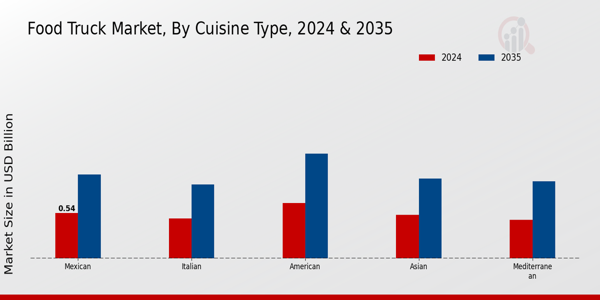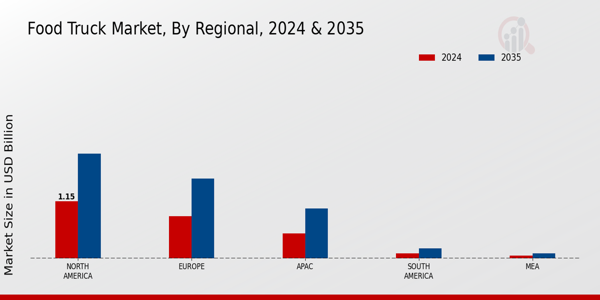Global Food Truck Market Overview:
As per MRFR analysis, the Food Truck Market Size was estimated at 2.51 (USD Billion) in 2023.The Food Truck Market is expected to grow from 2.66 (USD Billion) in 2024 to 5.0 (USD Billion) by 2035. The Food Truck Market CAGR (growth rate) is expected to be around 5.89% during the forecast period (2025 - 2035).
Key Food Truck Market Trends Highlighted
The growing desire from consumers for quick and distinctive dining experiences is fueling the food truck market. As the number of people living in cities increases, more people are looking for quick and convenient eating options.
Due to their varied menus that accommodate a range of palates and dietary requirements, food trucks have become more and more popular as a result. Additionally, many entrepreneurs are drawn to food trucks due to the cheaper initial investment needed to launch one as opposed to a typical restaurant, which promotes market expansion.
The food truck industry offers a plethora of chances for innovation and growth. Food truck owners can use applications for ordering and payment as mobile technology develops further, improving customer convenience.
Collaborations with local breweries, farmers' markets, and events create synergies that can increase foot traffic and brand visibility. Exploring sustainable practices could also resonate with environmentally conscious consumers, potentially leading to a more loyal customer base.
The adaptability of food trucks allows them to enter new markets quickly, tapping into various customer demographics. Recent trends highlight the emergence of gourmet food trucks that offer high-quality, specialty items, catering to food enthusiasts. Additionally, the fusion of international cuisines has gained traction, creating unique offerings that stand out in a crowded market.
Health-focused food trucks are also on the rise, with options geared toward well-being and nutrition. As consumers increasingly value transparency in food sourcing and preparation, food trucks that prioritize local ingredients may find a competitive edge.
Overall, the food truck market continues to evolve in response to consumer preferences, technological advancements, and a dynamic food landscape.

Source: Primary Research, Secondary Research, MRFR Database and Analyst Review
Food Truck Market Drivers
Rising Demand for Convenient Food Options
The Food Truck Market is experiencing a significant boost primarily due to the rising demand for convenient food options. As urbanization accelerates and lifestyles become busier, consumers are increasingly seeking quick and easy meal solutions that fit into their fast-paced lives.
Food trucks offer a unique appeal by providing fresh, ready-to-eat meals in various outdoor settings, such as parks, street fairs, and events. This convenience aligns perfectly with the modern consumer's preference for on-the-go eating experiences.
Furthermore, food trucks often feature diverse and globally inspired menus, catering to an array of dietary preferences and cultural tastes. The ability to offer meals that are both accessible and affordable significantly enhances the popularity of food trucks among consumers of all ages.
This demand is not only limited to urban centers but is also growing in suburban areas, expanding the market reach for food truck operators. With a projected continuous growth in the market, the food truck industry is set to evolve, incorporating innovative culinary trends and technology, such as online ordering and delivery services, which will enhance the customer experience.
As the expectation for versatile dining options rises, the food truck market is well-positioned, making it an enticing business opportunity for entrepreneurs. The potential for creativity in menu offerings and the ability to adapt quickly to consumer trends further support the market's expansion, ensuring that it remains relevant in a competitive foodservice landscape.
Growth of Food Tourism
The Food Truck Market is significantly influenced by the growth of food tourism. Travelers increasingly seek local cuisine experiences that reflect the cultural essence of the destinations they visit.
Food trucks are becoming a staple in many tourist spots, offering authentic and unique culinary experiences that allow visitors to savor local flavors without the need for formal dining. This trend drives both food truck profitability and consumer interest, ultimately expanding the market's footprint within the tourism sector.
Evolving Urban Landscape and Festivals
The evolving urban landscape is another major driver of the Food Truck Market. As cities expand and develop, public spaces increasingly accommodate food trucks, particularly during festivals, events, and local gatherings.
City planners and organizers recognize the value that food trucks bring to community engagement and city vibrancy. This supportive environment fosters growth opportunities for food truck businesses, ensuring they remain a prominent fixture in the urban food scene.
Food Truck Market Segment Insights:
Food Truck Market Cuisine Type Insights
The Food Truck Market was characterized by a diverse array of cuisine types, each contributing to the overall market dynamics. Among the various cuisine types, Mexican food trucks held a noteworthy position, valued at 0.54 USD Billion in 2024 and anticipated to grow to 1.0 USD Billion by 2035, showcasing its significant appeal and popularity among consumers.
This segment was particularly strong due to the vibrant flavors and the cultural influence of Mexican cuisine, which attracted a wide demographic, contributing to its majority holding in the Food Truck Market.
The Italian cuisine segment, valued at 0.48 USD Billion in 2024, is also expected to approach 0.88 USD Billion by 2035. The popularity of Italian dishes, such as pizza and pasta on the go, encourages frequent patronage from both families and young adults, making it a significant contributor to market growth.
Similarly, the American cuisine segment stood as a dominant force, valued at 0.66 USD Billion in 2024, and projected to grow to 1.25 USD Billion in 2035. This cuisine type benefited from its deep-rooted presence in street food culture across the United States, characterized by classic comfort foods that resonated well with a broad audience.
Asian cuisine, valued at 0.52 USD Billion in 2024 and likely to reach 0.95 USD Billion by 2035, emphasized the growing interest in bold flavors and diverse dishes. The increasing demand for Asian food truck offerings catered to a variety of palates seeking authenticity and fusion experiences, thus playing a crucial role in the Food Truck Market revenue.
Lastly, the Mediterranean cuisine segment, although the least valued at 0.46 USD Billion in 2024, is projected to double its presence to 0.92 USD Billion by 2035. Its appeal lay in health-conscious options with fresh ingredients, narrow targeting towards a specific demographic that values nutritious choices.
Overall, the Food Truck Market segmentation showcased a competitive landscape where various cuisines thrived based on consumer preferences and lifestyle trends. Market growth in these cuisine types was significantly influenced by authentic flavors, consumer convenience, and a growing street food culture, but each segment operated within a different demand context and influenced the overall market.
The cumulative data from these segments fortified the market dynamics and paved the way for emerging opportunities as food truck concepts evolve to meet changing consumer expectations.
In conclusion, the cuisine type segment of the Food Truck Market reveals both challenges and opportunities, demonstrating a vibrant tapestry of culinary offerings that enhance the marketplace's appeal and consumer connection while pushing the boundaries of traditional food consumption patterns.

Source: Primary Research, Secondary Research, MRFR Database and Analyst Review
Food Truck Market Service Type Insights
The market segmentation includes Full Service, Self-Service, and Takeaway, each playing a crucial role in expanding consumer reach and enhancing convenience.
Full Service, known for its comprehensive meal options and customer engagement, retains a significant share, appealing to food enthusiasts looking for an immersive dining experience. Self-service offers flexibility, catering to customers who prefer a quick and individual dining option, aligning with busy lifestyles.
Takeaway services are also major contributors, driven by the rising trend of on-the-go meals, particularly among urban populations. As the Food Truck Market data shows, the increasing demand for food trucks reflects a shifting consumer preference for unique culinary experiences, contributing to robust market growth.
The industry faces challenges such as regulatory barriers and competition yet continues to find opportunities in evolving food trends and consumer preferences. Overall, the Service Type segment remains vibrant, underpinning the diverse offerings that define the Food Truck Market statistics.
Food Truck Market Ownership Type Insights
Within the Ownership Type segment, the market is divided among Independent, Franchise, and Corporate categories, each playing a pivotal role in shaping the industry.
Independently owned food trucks are often considered the backbone of local cuisine, offering unique and diverse meals that appeal to a growing consumer base seeking authentic experiences. Franchised food trucks provide brand recognition and standardized offerings, capitalizing on the rising trend of food trucks as a viable business model.
Corporate-owned trucks typically benefit from established infrastructure and resources, allowing for scalability and broader market reach. As food trucks continue to gain popularity, their adaptability and lower overhead compared to traditional restaurants present significant opportunities for growth, while also facing challenges like regulatory compliance and market saturation.
Overall, the dynamic landscape of the Food Truck Market segmentation shifts continually, driven by consumer preferences and economic factors, revealing the intricate relationship between ownership types and their impact on market growth.
Food Truck Market Fuel Type Insights
The Fuel Type segment of the Food Truck Market is characterized by diverse energy sources, with a strong emphasis on Diesel and Natural Gas.
Diesel fuel has historically dominated due to its efficiency and widespread infrastructure, but Natural Gas is gaining traction as businesses seek to reduce emissions and operating costs. Electric food trucks are emerging, driven by technological advancements and environmental considerations, appealing to eco-conscious consumers.
Hybrid models, which combine traditional and alternative fuels, are also becoming significant for their flexibility in fuel usage, catering to a wider operational range. The Food Truck Market segmentation showcases a shift towards cleaner energy solutions, which are essential for market growth, though challenges like initial vehicle costs and charging infrastructure remain prominent.
In the evolving landscape of the food service industry, the drive for sustainable operations presents opportunities for further innovations in the fuel types utilized within the market.
Food Truck Market Regional Insights
The Food Truck Market showcased significant growth in the regional segment, with varying valuations across different areas. In 2024, North America held the majority share, valued at 1.15 USD Billion, and is expected to grow to 2.1 USD Billion by 2035, emphasizing its dominance in the industry due to established food culture and consumer preferences.
Europe followed with a valuation of 0.85 USD Billion in 2024, projected to reach 1.6 USD Billion in 2035, reflecting the region’s increasing culinary diversity and mobile dining options. The Asia-Pacific (APAC) region, worth 0.5 USD Billion in 2024 and anticipated to reach 1.0 USD Billion by 2035, offered promising growth opportunities as urbanization and food trends evolve.
In contrast, South America and the Middle East and Africa (MEA) were smaller segments, valued at 0.1 USD Billion and 0.06 USD Billion in 2024, respectively, and forecasted to increase to 0.2 USD Billion and 0.1 USD Billion by 2035, showcasing their emerging yet significant potential as food truck markets developed and local tastes diversify.
Overall, the Food Truck Market segmentation highlighted the varying growth dynamics and opportunities in each region, driven by local demand and food culture.

Source: Primary Research, Secondary Research, MRFR Database and Analyst Review
Food Truck Market Key Players and Competitive Insights:
The competitive landscape of the Food Truck Market is characterized by a blend of innovation, culinary diversity, and adaptability as various players strive to meet the growing consumer demand for convenient and unique dining experiences. This market has evolved significantly, with a shift towards offering gourmet meals on wheels, reflecting changing consumer preferences for high-quality food, sustainability, and local sourcing.
Moreover, the rise of food truck culture has led to increased competition among operators, driving them to differentiate their offerings and enhance customer engagement through various platforms and technologies. As businesses navigate this competitive terrain, understanding key players, trends, and strategies becomes crucial for sustained growth and success in this dynamic environment.
Within the Food Truck Market, Street Food App has positioned itself as a strong contender, leveraging technology to enhance the overall consumer experience. The app provides a user-friendly platform for customers to locate food trucks in their vicinity, view menus, and place orders ahead of time, thus streamlining the dining process.
By facilitating connections between food truck operators and patrons, Street Food App significantly raises market visibility for food trucks while allowing operators to manage sales effectively and gather valuable customer insights.
Furthermore, its comprehensive review system and strong social media integration foster community engagement and loyalty, empowering food trucks to cultivate a dedicated customer base and create a competitive edge in an evolving market.
Roaming Hunger is another influential player in the Food Truck Market, renowned for its extensive network of food trucks across various urban landscapes. The company excels in connecting consumers with an array of food truck options, catering to diverse culinary tastes and preferences.
Roaming Hunger's strong emphasis on technology-driven solutions enables them to offer real-time tracking of food trucks, along with customizable booking services for events, which enhances convenience for both customers and food truck operators.
Additionally, their commitment to promoting local food trucks through partnerships and marketing efforts underscores their role in supporting small businesses. By offering a user-centric platform and extensive market reach, Roaming Hunger continues to assert itself as a leading force in the market, capitalizing on the trends that shape the future of mobile dining.
Key Companies in the Food Truck Market Include:
- Street Food App
- Roaming Hunger
- Tasty Spud
- Food Truck Nation
- The Taco Truck
- The Lobos Truck
- Gourmet Food Trucks
- Food Truck Empire
- Curbside Cuisine
- The Grilled Cheese Truck
- Frysmith
- Gastro Garage
- Kogi BBQ
- Curry Up Now
- The Food Truck Company
Food Truck Market Developments
Recent developments in the Food Truck Market indicate a dynamic shift in consumer preferences and operational strategies among key players. Companies like Street Food App and Roaming Hunger have seen an uptick in app-driven food delivery services, leveraging mobile technology to enhance customer convenience and streamline operations.
The Taco Truck and The Lobos Truck are expanding their menus to include gourmet options, catering to the growing demand for unique and high-quality food experiences. Additionally, Kogi BBQ and Curry Up Now have been noted for their innovative fusion cuisine, appealing to diverse demographics and cultures.
In terms of mergers and acquisitions, while no recent significant transactions involving the named companies have been publicly disclosed, the market continues to attract interest from investors looking to capitalize on the growing food truck trend.
Moreover, as the valuation of companies like Gourmet Food Trucks and Gastro Garage rises, there is an increasing focus on sustainability and local sourcing, which is reshaping how food trucks operate and market themselves. As the food truck industry continues to grow, these factors will likely play a crucial role in shaping future trends and opportunities.
Food Truck Market Segmentation Insights
-
Food Truck MarketCuisine TypeOutlook
- Mexican
- Italian
- American
- Asian
- Mediterranean
-
Food Truck MarketService TypeOutlook
- Full Service
- Self-Service
- Takeaway
-
Food Truck MarketOwnership TypeOutlook
- Independent
- Franchise
- Corporate
-
Food Truck MarketFuel TypeOutlook
- Diesel
- Natural Gas
- Electric
- Hybrid
-
Food Truck MarketRegionalOutlook
- North America
- Europe
- South America
- Asia Pacific
- Middle East and Africa
| Attribute/Metric Source: |
Details |
| MARKET SIZE 2023 |
2.51(USD Billion) |
| MARKET SIZE 2024 |
2.66(USD Billion) |
| MARKET SIZE 2035 |
5.0(USD Billion) |
| COMPOUND ANNUAL GROWTH RATE (CAGR) |
5.89% (2025 - 2035) |
| REPORT COVERAGE |
Revenue Forecast, Competitive Landscape, Growth Factors, and Trends |
| BASE YEAR |
2024 |
| MARKET FORECAST PERIOD |
2025 - 2035 |
| HISTORICAL DATA |
2019 - 2024 |
| MARKET FORECAST UNITS |
USD Billion |
| KEY COMPANIES PROFILED |
Street Food App, Roaming Hunger, Tasty Spud, Food Truck Nation, The Taco Truck, The Lobos Truck, Gourmet Food Trucks, Food Truck Empire, Curbside Cuisine, The Grilled Cheese Truck, Frysmith, Gastro Garage, Kogi BBQ, Curry Up Now, The Food Truck Company |
| SEGMENTS COVERED |
Cuisine Type, Service Type, Ownership Type, Fuel Type, Regional |
| KEY MARKET OPPORTUNITIES |
Rising demand for unique cuisines, Increasing popularity of street food, Growth in food delivery services, Expansion in urban areas, Emerging eco-friendly food trucks |
| KEY MARKET DYNAMICS |
growing consumer preference for street food, increasing urbanization and food trucks, lower startup costs and operational flexibility, diverse cuisine offerings and innovation, popularity of food festivals and events |
| COUNTRIES COVERED |
North America, Europe, APAC, South America, MEA |
Frequently Asked Questions (FAQ) :
The Global Food Truck Market is expected to be valued at 2.66 USD Billion in 2024.
By 2035, the Global Food Truck Market is projected to reach a value of 5.0 USD Billion.
The Global Food Truck Market is expected to grow at a CAGR of 5.89% from 2025 to 2035.
In 2024, North America holds the largest market share in the Global Food Truck Market, valued at 1.15 USD Billion.
The Asian cuisine segment is valued at 0.52 USD Billion in the Global Food Truck Market for 2024.
Major players in the Global Food Truck Market include Street Food App, Roaming Hunger, and The Taco Truck.
The Italian cuisine segment is expected to be valued at 0.88 USD Billion in the Global Food Truck Market by 2035.
The Mediterranean cuisine segment is expected to be valued at 0.46 USD Billion in 2024.
By 2035, the market value for South America in the Global Food Truck Market is projected to reach 0.2 USD Billion.
The American cuisine segment is expected to reach a market value of 1.25 USD Billion by 2035.

















